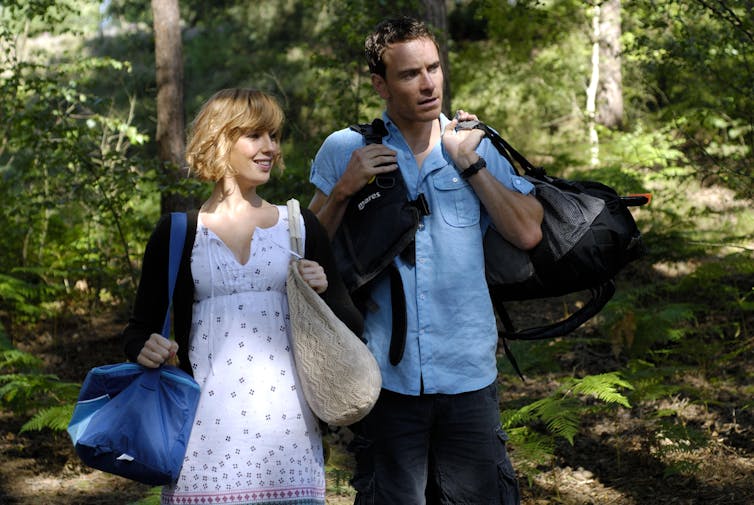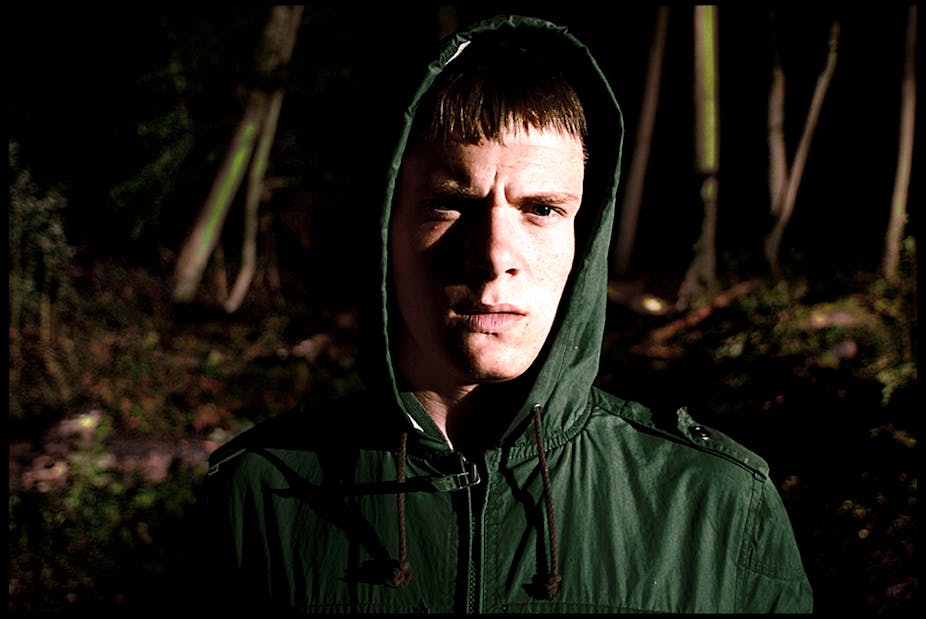On Halloween 2008, James Watkins’ horror feature Eden Lake was released to little fanfare. A British take on the “backwoods” horror film (think Deliverance or Wrong Turn), it was just one of a swathe of low-budget horrors being produced at this time.
Critic MJ Simpson identified Eden Lake as exemplary of the British horror revival, which began in the late 1990s after a period of relative quiet. Following the demise of horror behemoth Hammer Studios in the 1970s and sustained attacks from censors and the government on extreme cinema throughout the late 20th century (reaching their peak during the “video nasties” panic), British horror had struggled to recover its footing.
However, the new millennium, along with high-profile releases like Danny Boyle’s 28 Days Later (2002) and Edgar Wright’s Shaun of the Dead (2004), galvanised British horror. As a result, productions large and small proliferated throughout the 2000s.
Eden Lake became the first of a series of “hoodie horrors”, which closely examined Britain’s relationship to, and reliance upon, a deeply entrenched class system. This was the time of Tony Blair’s Labour government and its tough policies on antisocial behaviour that targeted the young and the poor.
Other “hoodie horrors” followed, including Attack the Block (2011) and Citadel (2012). However, while these films focus specifically on the urban landscape, finding horror within Britain’s oft-vilified council estates, Eden Lake is more interested in revisiting (and perhaps compounding) the horror genre’s common, and deeply derogatory, representation of the rural poor.
In 2021, the Labour party are once again turning towards policies that show that they are tough on crime and tough on antisocial behaviour, while the government recently unveiled a “Beating Crime” strategy as part of its policy to “level up” the country. As such, this Halloween is an apt time to revisit Eden Lake and its “hoodie horror” peers, to investigate how the genre at large mines the British class system to frighten audiences.
Tony Blair’s Asbos
Tony Blair supported the anti-social behaviour order (Asbo) in 1998 as part of his “respect” agenda. The Asbo supposedly worked as a pre-emptive measure, identifying and punishing antisocial behaviour before it graduated to criminality. But the number of Asbos issued rose annually, and dramatically, during the early 2000s, and they soon became synonymous with young, working-class men in particular.
In the decade leading up to Eden Lake’s 2008 release, the hope and optimism that had accompanied the election of New Labour in 1997 had dramatically dissipated. The Asbos and the “respect agenda” were part of this, sowing new seeds of division across people from different classes. People who might have come together under the Blairite messages of community and unity were now turning against each other.
As sociologist Imogen Tyler suggests, many facets of the Blairite “respect” agenda reinforced the idea that Britain’s poor existed outside of the accepted social order. The image of the delinquent, hood-clad teenager captured the public imagination and worked its way into horror cinema through films like Eden Lake.
Watkins portrays such working-class exclusion quite literally in the film. The young, working-class antagonists occupy the outer edges of a rural backwater, isolated from the affluent metropolis within which the film’s entitled protagonists reside.
Contrast this with other “hoodie horror” films, such as The Disappeared (2008), Tower Block (2011) and Community (2012), which represent the working-class space as a kind of urban “border-zone”. It is a location that exists within an otherwise affluent, middle-class cityscape; yet it is aggressively maligned and separated from the wider locale through both physical and imagined boundaries. It is also dogged by perceptions of threat and danger.
Yet while Eden Lake is set in a different context, the representation of working-classness are not too dissimilar. Here, the countryside backwater also reflects and amplifies the “real-world” criminalisation of the young working-class. The youths reside here in an untamed space where the order of the city is seemingly nowhere to be found.
Straight from the headlines
By 2008, the Asbo had become shorthand for the poorly behaved, criminally inclined working classes in the British press. Along with the liberal use of terms such as “chav” and “hoodie”, the media openly stoked the fires of class contempt in post-millenium Britain. And as “hoodies” began appearing with alarming regularity within the British horror canon, these figures were often unambiguously coded as evil – at best as delinquent teenagers and, at worst, as literally inhuman, as in Heartless (2009).
Watkins mines the same tabloid rhetoric in characterising his monsters – a group of working-class teenagers (all but one of them boys) whose supposedly inherent delinquency escalates to horrific, depraved violence as the film progresses. In pitting an aspirational middle-class couple, Steve and Jenny, against this group of aggressively antisocial youths, Eden Lake’s antagonists appear to have leapt directly from a tabloid headline onto the screen.
Watkins does attempt, albeit weakly, to challenge such a simplistic understanding of the film’s representation of class. As tensions rise between Steve, Jenny and the young people, we see gentrification and disenfranchisement in action.
Steve and Jenny, in their flashy car and their designer sunglasses, don’t unwittingly trespass upon working-class space. Rather, they occupy this space with the confidence of people who’ve never had to justify their presence anywhere. Indeed, they feel completely entitled to demand that the kids vacate the space, so that they may enjoy it without interruption.

Such a request betrays ignorance or denial of the working class’s right to space – to claim it or to belong in it. Their attempts to monitor and correct the behaviour of the kids provide the catalyst for a series of increasingly violent and gruesome acts of vengeance from both parties. This results in a film whose stance on class and violence is slightly more ambiguous than it first seems as Jenny and Steve also act violently towards the teenagers, and are no longer simple victims.
That’s not to say the film tries too hard to elicit any kind of sympathy for its young working-class antagonists. The group exhibit all the stereotyped behaviours of “hoodies” from the outset – from blaring loud music to theft and property damage. Watkins has still borrowed heavily from the Blairite definition of “antisocial”.
Despite its increasingly unlikeable protagonists, Watkins ultimately trades too enthusiastically on the stereotypes of “hoodies” to meaningfully critique unfair perceptions of them – as do many other “hoodie horrors”. Whatever ambiguity Watkins aims to cultivate fails. In the end, Eden Lake doesn’t offer an exploration of Britain’s entrenched classism, but rather becomes an opportunistic exploitation of it.


